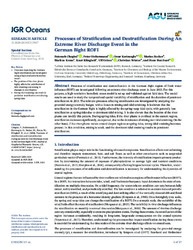Processes of Stratification and Destratification During An Extreme River Discharge Event in the German Bight ROFI
Kreus, Markus
Chegini, Fatemeh; Holtermann, Peter; Kerimoglu, Onur; Becker, Marius; Kreus, Markus; Klingbeil, Knut; Gräwe, Ulf; Winter, Christian; Burchard, Hans, 2020: Processes of Stratification and Destratification During An Extreme River Discharge Event in the German Bight ROFI. In: Journal of Geophysical Research: Oceans, Band 125, 8, DOI: 10.23689/fidgeo-4028.
 |
Dokument öffnen: |
Processes of stratification and destratification in the German Bight region of fresh water influence (ROFI) are investigated following an extreme river discharge event in June 2013. For this purpose, a high‐resolution baroclinic ocean model is set up and validated against field data. The model results are used to study the temporal and spatial variability of stratification and the duration of persistent stratification in 2013. The relevant processes affecting stratification are investigated by analyzing the potential energy anomaly budget, with a focus on mixing and tidal straining. It is shown that the stratification in the German Bight is highly affected by the spring‐neap tidal cycle, with generally less stratification at spring tides due to dominant tidal mixing. It is also shown that the location of the river plume can modify this pattern. During spring tides, if the river plume is confined to the eastern region, stratification decreases significantly, as expected, due to the dominance of mixing over tidal straining. On the other hand, if the river plume moves toward deeper regions at spring tides, strong tidal straining becomes present. In this condition, mixing is weak, and the dominant tidal straining results in persistent stratification. Key Points:
Processes impacting the German Bight stratification are investigated using a high‐resolution baroclinic model.
The position of the river plume highly affects the contribution of tidal straining and mixing to changes in stratification.
Strong tidal straining can result in persistent stratification even during spring tides.
Statistik:
ZugriffsstatistikSammlung:
Schlagworte:
stratificationtidal‐straining
mixing
extreme river discharge
numerical model
German Bight ROFI
This is an open access article under the terms of the Creative Commons Attribution License, which permits use, distribution and reproduction in any medium, provided the original work is properly cited.

